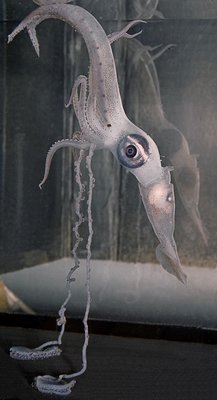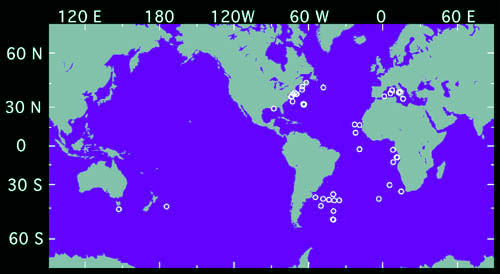Chiroteuthis veranyi
Clyde F. E. Roper and Richard E. YoungIntroduction
C. veranyi is the type species of the genus. It has a rich and varied history (see Nomenclature), based in part on its description in an era when few systematic characters were recognized and these were poorly defined, and in part because of the unusual, large paralarval stage that typifies the family. This species has a broad distributional range and future studies may show that this is a complex of closely-related species rather than the single species presently recognized.
The title photograph shows a squid in an aquarium with the ventral arms uppermost. This is reversed from what has been seen in situ from submersibles (i.e., an oblique attitude with arms up but with the dorsal arms uppermost).
Diagnosis
A Chiroteuthis ...
- with short club divided into two nearly equal sections by protective membranes.
- with trabeculae, in the proximal protective membrane of the club, fused at bases and undivided at tips.
- with photophores on eyeball in strips and two photophores on viscera.
Characteristics
- Arms
- Largest arm suckers not globular nor greatly enlarged.
- Large arm suckers with pointed teeth on distal margin of ring.
- Tentacular clubs
- Club suckers with central tooth enlarged.
- Club sucker stalks in two distinct parts; stalks of lateral sucker series about twice as long as those of medial sucker series.
- Club protective membranes
- Membranes in two distinctive sets of nearly equal length.
- Photophores
- Eyeball photophores: lateral series= stripe; intermediate series = 3 (2 posterior:large , small; 1 anterior); medial series = stripe.
- Visceral photophores: Pair present.
- Pigmentation
- Club sucker bases with pleats in short, well-defined region.
- Buccal membrane unpigmented???.
Figure. Aboral view of the tentacular club of C. veranyi showing the proximal and distal protective membranes. Drawing by A. D. Hart (© C. Roper).
Comments
More details of the description of C. veranyi can be found here.
The appearance of the visceral photophores are very different from those of C. spoeli (see Life History on the Chiroteuthis page). In C. veranyi the photophores are more imbedded in the ink sac and seem to have a different internal structure.
Figure. Ventral view of the visceral photophores of C. veranyi. Photograph by M. Vecchione.
Nomenclature
This species was originally described as Loligopsis veranyi by Ferussac in 1835 for a specimen from the Mediterranean Sea. The genus Chiroteuthis was erected for this species by Orbigny in 1841 [In Ferussac and Orbigny, 1834-1848]. This remained the sole species in the genus until 1881 when Verrill described Chiroteuthis lacertosa from the western Atlantic Ocean off Nova Scotia, followed shortly thereafter by his Leptoteuthis diaphana in 1884, a juvenile from off New Jersey, western Atlantic.
Although Ficalbi (1899) asserted that Doratopsis vermicularis Rochebrune, 1884 was the larval form and synonym of Chiroteuthis veranyi, this relationship was not generally accepted until confirmed by Naef (1923). Naef also indicated that Verrill's Leptoteuthis diaphana was a transitional stage between the doratopsis and subadult of C. lacertosa.
Pfeffer (1912) recognized two subspecies, C. veranyi veranyi, from the Mediterranean and eastern Atlantic and C. veranyi lacertosa from the western Atlantic from Nova Scotia to the Caribbean region. Nesis (1982/87) concurred with the subspecific designations and expanded the known geographical distribution of C.veranyi veranyi to include southern subtropical areas of the Indian and Pacific Oceans. We find no differences between C. veranyi and C. lacertosa at the specific or subspecific levels. C. veranyi, however, is a broadly distributed species that exhibits considerable geographic variation over its range. See Naef(1923) for complete synonomy.
The holotype of C. lacertosa (= synonym) is deposited in the National Museum of Natural History in Washington. It is in its original poor condition, with tentacles lacking, as when originally described.
Life history
The early life-history stages have been described by Ficalbi, Verrill and Naef. Nevertheless, separation of doratopsis stages from co-occurring species has not been achieved. Little else is known of the life history of C. veranyi.
Distribution
C. veranyi is found throughout most of the Atlantic and the southern subtropical areas of the Indian, and Pacific Ocean (Nesis, 1987).
Figure. Distribution map of C. veranyi based only on capture data from specimens present in the collections of the U. S. National Museum of Natural History. Map by R. Young.
Little is known about the vertical distribution of this species. Roper and Young (1975) report a single record of a subadult taken at a depth of 400 m in the Mediterranean at night.
References
Chun, C. 1910. Die Cephalopoden. Oegopsida. Wissenschaftliche Ergebnisse der Deutschen Tiefsee-Expedition, "Valdivia" 1898-1899, 18: 1-522 + Atlas.
Ferussac, A. d’. 1835. Sur deux genres de Cephalopodes encore peu connus les genres Calmaret and Cranchie et sur une nouvelle espece for remarquable de chacun de ces deus genres. Magsin de Zoologie, annee V, classe V, 10 pp.
Ficalbi, E. 1899. Unicita di specie delle due forme di Cefalopodi pelagici chiamate Chiroteuthis veranyi e Doratopsis vermicularis. Monit. Zoologie Italia, 10.
Naef, A. (1921/23). Cephalopoda. Fauna e Flora del Golfo di Napoli. Monograph, no. 35. English translation: A. Mercado (1972). Israel Program for Scientific Translations Ltd., Jerusalem, Israel. 863pp., IPST Cat. No. 5110/1,2.
Nesis, K. N. 1982/87. Abridged key to the cephalopod mollusks of the world's ocean. 385+ii pp. Light and Food Industry Publishing House, Moscow. (In Russian.). Translated into English by B. S. Levitov, ed. by L. A. Burgess (1987), Cephalopods of the world. T. F. H. Publications, Neptune City, NJ, 351pp.
Pfeffer, G. 1912. Die Cephalopoden der Plankton-Expedition. Ergebniss der Plankton-Expedition der Humboldt-Stiftung. 2: 1-815.
Roper, C. F. E. and R. E. Young. 1975. Vertical distribution of pelagic cephalopods. Smithsonian Contributions to Zoolog, 209: 1-51.
Verrill, A.E. 1881. The cephalopods of the north-eastern coast of America. Part II. The smaller cephalopods, including the “squids” and the octopi, with other allied forms. Trans. Connecticut Acad. Sciences, 5: 259-446.
Verrill, A.E. 1884. Second catalogue of the Mollusca, recently added to the fauna of the New England coast and the adjacent parts of the Atlantic, consisting mostly of deep-sea species, with notes on others previously recorded. Trans. connecticut Academy Scineces, 6: 133-294.
Young, R. E. (1972). The systematics and areal distribution of pelagic cephalopods from the seas off Southern California. Smithson. Contr. Zool., 97: 1-159.
About This Page

Smithsonian Institution, Washington, D. C., USA

University of Hawaii, Honolulu, HI, USA
Page copyright © 2019 and
All Rights Reserved.
- Content changed 31 October 2018
Citing this page:
Roper, Clyde F. E. and Richard E. Young. 2018. Chiroteuthis veranyi . Version 31 October 2018 (under construction). http://tolweb.org/Chiroteuthis_veranyi/19479/2018.10.31 in The Tree of Life Web Project, http://tolweb.org/












 Go to quick links
Go to quick search
Go to navigation for this section of the ToL site
Go to detailed links for the ToL site
Go to quick links
Go to quick search
Go to navigation for this section of the ToL site
Go to detailed links for the ToL site